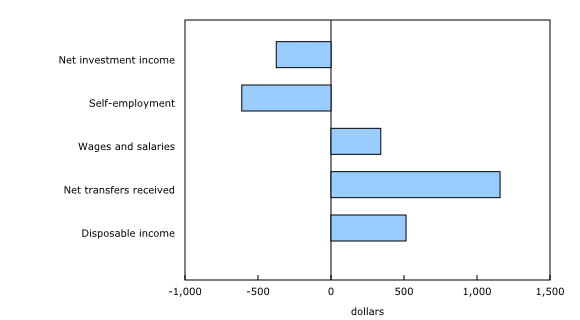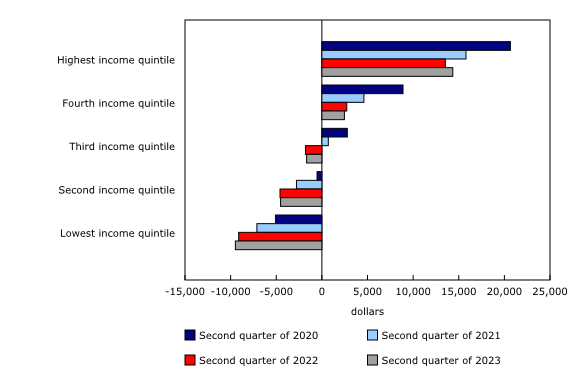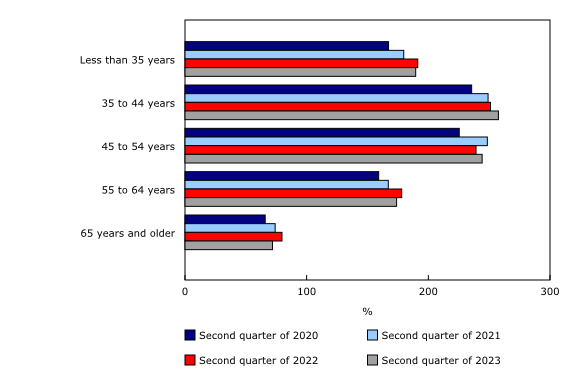The income gap or inequality—defined as the gap in the share of disposable income between households in the top 40% and bottom 40% of the income distribution—declined to 45.1% in the second quarter, returning to levels that prevailed prior to the COVID-19 pandemic. The income gap was down from a high of 47.0% recorded in the second quarter of 2022, when the expiry of government COVID-19 support benefits in combination with weaker labour market conditions pushed the income gap to a historical high.

The income gap for lower-income households declined from a historic high due to enhanced benefits for retirees and wage gains for workers
The lowest income households—those in the bottom 20% of the income distribution—had strong gains in average disposable income in the second quarter of 2023 relative to the same quarter of 2022, due mainly to increased transfers (+20.1% vs. +3.6% for all households). The 10% top-up to Old Age Security benefits for seniors 75 years and older accounted for more than one-quarter of the overall increase in transfers to the lowest-income households. In the second quarter of 2023, 40.5% of the lowest-income households claimed government transfers as a primary source of income, up from 35.7% a year earlier.
Meanwhile, strong labour market conditions had more of an impact on incomes for households in the second income quintile, as increases in their wages accounted for two-thirds of the increase in their disposable income (+6.9% vs. +3.3% for all households).
Increasing interest rates had a negative impact on disposable income for the lowest-income households, as the average net investment income for these households declined in the second quarter of 2023. Credit card balances had a more significant impact on the lowest income households, as increases in interest charges were evenly split between credit cards and mortgages for the lowest income households, while the average household dedicated two-thirds of the overall increase in interest payments to mortgage-related debt.
Highest-income households gain from employment and investment
For the highest-income households (top 20%), average disposable income increased at a slower-than-average pace in the second quarter relative to a year earlier (+2.6% vs. +3.3% for all households). Gains occurred for wages and salaries (+3.0%), self-employment income (+11.2%) and net investment income (+15.2%), mainly from dividends and interest on bank deposits, while increases in interest charges had a relatively minor impact on net investment income.
Gains in employment income and investment earnings for the highest income households were partially offset by reductions in net transfers received (-13.2%), as the number of households claiming government benefits as a main source of income declined by one-third in the second quarter from the second quarter of 2022. An increase in taxes paid by the highest-income households (+6.9%) also weighed on disposable income.
Lowest-income households’ net savings decline as cost-of-living increases outweigh income gains
In contrast with a gain in net saving for the highest income households, which rose in the second quarter relative to a year earlier (+6.0%; +$816), net saving for the lowest income households decreased (-3.9%; -$360) over the same period as income gains for these households did not match cost-of-living increases, especially for clothing and footwear as well as for transport.
The wealth gap widens relative to a year earlier but remains lower than before the COVID-19 pandemic
Most wealth is held by relatively few households in Canada. The wealthiest (top 20%) accounted for more than two-thirds (67.8%) of net worth in the second quarter, while the least affluent (bottom 40%) accounted for 2.7%.
The latest estimates indicate a reversal of circumstances for the least wealthy over the last year relative to trends observed during the pandemic. From the end of 2019 to the end of 2021, the wealth gap dropped by 1.5 percentage points, the largest decline on record. In contrast, over a period of one year, from the second quarter of 2022 to the second quarter of 2023, the gap in wealth between the top 20% and the bottom 40% increased by 0.6 percentage points, ranking among the largest increases on record for these estimates.
The least wealthy households were affected more by recent economic pressures, as their net worth decreased by 1.3% in the second quarter of 2023 relative to the same quarter a year earlier. Only the least wealthy households had lower average net worth during this period, while net worth for households overall increased by 2.0%.
Least wealthy households reduce net worth as mortgage debt increases
Although the least wealthy held and acquired real estate, their average net worth declined in the second quarter relative to a year earlier as the increase in mortgage debt to finance those assets (+8.4%) outweighed the increase in the value of their real estate holdings (+3.9%). On average, real estate prices declined by 4.8% in June 2023 relative to a year earlier.
In contrast with the least wealthy households, the wealthiest (top 20%) had a faster-than-average increase in net worth (+2.7% vs. +2.0% for all households) in the second quarter relative to a year earlier, derived entirely by financial asset gains (+6.6%). The average value of real estate for the wealthiest households declined by 2.8% over the same period, on par with reductions observed for the average household (-2.1%). Meanwhile, debt was relatively stable, growing by 1.0% as the wealthiest avoided higher levels of borrowing.
Youngest households’ mortgage debt declines, while affordability concerns mount
From the second quarter of 2020 to the second quarter of 2022, as the Bank of Canada decreased interest rates to stimulate the economy, the youngest households—those aged less than 35 years—had the fastest growth in average mortgage debt (+22.4% compared with +17.3% for all households). However, more recently, along with rapid interest rate increases from the second quarter of 2022 to the second quarter of 2023, average mortgage debt for the youngest households declined at the fastest pace (-2.8% compared with +1.8% for all households).
Households in the youngest age group—those aged less than 35 years—may be reducing their mortgage balances for various reasons. Prospective homeowners may be turning away from the housing market due to affordability concerns, while existing homeowners who purchased a home when interest rates were much lower a few years ago may be paying off their existing mortgage debt balances or moving into more affordable accommodations.
Youngest households’ debt-to-income ratio declines while debt service ratio increases
Debt-to-income ratios were the highest for core working-age households in the second quarter, and they also had the highest growth relative to the same period a year earlier, including those aged 35 to 44 years (+6.4 percentage points) and those aged 45 to 54 (+5.0 percentage points). Debt for core working-age households increased by more than disposable income, as employment income gains were offset by higher debt charges. Over the same period, the debt-to-income ratio declined for the youngest households (less than 35 years) and seniors (aged 65 years and older). While the ratio for the youngest households declined due to reductions in mortgage debt combined with strong wage gains, older households benefitted from enhanced retirement benefits targeted to low-income households.
An alternative indicator of household financial risk is the interest-only debt service ratio (DSR), which is based on the value of total interest payments on credit market debt as a share of household disposable income. The DSR was higher for younger age groups in the second quarter, reaching 12.5% for those aged 35 to 44 years (+4.5 percentage points from the second quarter of 2022) and 11.5% for those aged less than 35 years (+4.1 percentage points).
Even though the decline in the debt-to-income ratio for the youngest age group indicates that they are carrying less debt in the second quarter of 2023 relative to a year earlier, they continue to pay more to service their remaining debt due to increases in interest rates over the same period.
Persistently high interest rates and inflation will continue to strain households’ ability to make ends meet without going further into debt, especially vulnerable groups, such as those with the lowest income, the least wealth and in the younger age groups. The latest figures from the Monthly Credit Aggregates program indicate that household debt continued to grow up to July 2023, although there was a continued slowdown in mortgage borrowing as interest rates and relatively high home prices likely dissuaded buyers.
Note to readers
Allymonews regularly publishes macroeconomic indicators on household disposable income, final consumption expenditure, savings and wealth as part of the Canadian System of Macroeconomic Accounts (CSMA). These accounts are aligned with the most recent international standards and are compiled for all sectors of the economy, including households, non-profit institutions, governments and corporations along with Canada’s financial position vis-à-vis the rest of the world. While the CSMA provides high-quality information on the overall position of households relative to other economic sectors, the Distributions of Household Economic Accounts (DHEA) provide additional granularity to address questions such as vulnerabilities of specific groups and the resulting implications for economic well-being and financial stability. These estimates are an important complement to standard quarterly outputs related to the economy.
The DHEA estimates released today provide estimates of income, consumption, saving and wealth, including their sub-components by various household distributions up to the second quarter of 2023. Estimates have also been revised for prior periods to incorporate the latest CSMA benchmarks, including revisions back to the first quarter of 2023.
Definitions and Terminologies
The term “income gap”, referred to in this text, is defined as the gap in the share of disposable income between households in the top 40% and bottom 40% of the income distribution. The “wealth gap” is defined as the gap in the share of net worth between households in the top 20% and bottom 40% of the wealth distribution. Estimates for net worth distributed by wealth quintile are combined for households in the lowest two quintiles for ease of illustration, since the average household in the lowest wealth quintile owed more in liabilities than it owned in assets, such as self-employed workers with negative net business equity and recent graduates with student loan balances.
As with all data, the DHEA estimates are not without their limitations. While some distributions are estimated using timely microdata or micromodels, such as wages and salaries and household debt, other distributions, including those for household final consumption expenditures, social transfers in kind and assets rely on assumptions or use data from prior reference periods. Users should keep these limitations in mind when analyzing the estimates included in this release.
All values are expressed in nominal unadjusted rates. As a result, the estimates presented in this release are not adjusted for variations over time that may occur due to seasonal patterns and/or price inflation. Since the quarterly series are not seasonally adjusted, comparisons should only be made using estimates for the same quarter of each year.









